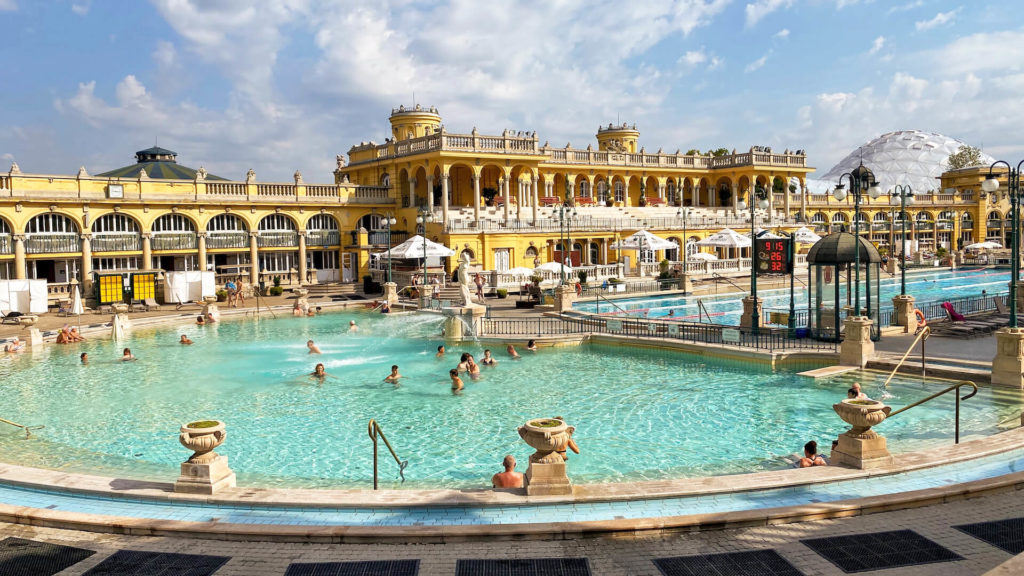Spas & Thermal Baths in Budapest

The History of Budapest’s Thermal Baths
Budapest’s thermal baths have a rich and fascinating history. The remains of the Roman-era public baths, Thermae Maiores, are still visible in today’s northern Budapest. During the Ottoman Empire, between 1541 and 1686, many renowned spas were built, including Rudas, Kiraly, and Veli Bej. These Turkish-style bathhouses still function today.
Another wave of bathhouse-building frenzy took place during Budapest’s golden years under the Austro-Hungarian Empire in the early 20th century. These striking baths are inside lavish classical revival and Art Nouveau buildings, with the best examples being Szechenyi and Gellert.
The Benefits of Thermal Bathing
While science has yet to verify the healing effects of balneotherapy, the treatment of pain in thermal water, many people believe that mineral-rich water is a useful supplement to standard treatments. Thermal bathing is not just for treating ailments; it is also a great way to relax, reflect, and socialize.
Social gatherings and information exchange have traditionally been central to Budapest bathhouses. This was especially true during the most repressive years of the Communist-era when hiding amid clouds of mist and the background noise of running water was a relatively safe refuge for covert political discussions.
Budapest’s Thermal Baths
Gellert Thermal Bath
Rudas Thermal Bath
Széchenyi Thermal Bath
Lukács Baths

Király Baths
Király Baths is a good and affordable option if you’re looking for a traditional thermal bathing experience away from the crowds. The Turkish baths date to 1565, and the main pool sits under a classic Ottoman dome dotted with skylights. The site was damaged during World War II and renovated in 1950. It now features steam baths, saunas, underwater massage jets, and pools fed by thermal waters from the nearby Lukács Baths.
Other Thermal Baths
Apart from the five thermal baths mentioned above, Budapest also has four other medicinal baths, including Dandár Thermal Bath, Paskál Thermal Bath, Csillaghegyi Thermal Bath, and Palatinus Thermal Bath. Each bath has its unique features, and you can choose one according to your preferences.
What to Expect When You Visit
Before you visit any spa in Budapest, you should check if their swimming pools are mixed since most thermal baths are open on certain days for men and others for women. Bathers are expected to wear a swimsuit at all times in Budapest’s baths, and swim caps are mandatory accessories when swimming in the lap pools. Finally, bring flip flops! They’re useful when walking between the indoor and outdoor pools.
In Budapest’s baths, don’t stay in the hot thermal pools for longer than 20 minutes, don’t swim in the thermal pools if you’re under 14, and don’t smoke. Smoking is not permitted in any of the thermal baths, including the open-air spots.
FAQs
What are the thermal baths in Budapest?
Thermal baths in Budapest are a part of Hungarian tradition and history, stemming from both Turkish influence during their occupation of Hungary in the 16th and 17th centuries and the country's geological advantage of being rich in thermal waters. Notable thermal baths include Széchenyi Thermal Bath, Gellért Thermal Bath, Rudas Baths, and Lukács Baths, among others.
What is unique about the thermal baths in Budapest?
The thermal baths in Budapest are known for their healing properties. These baths are rich in minerals such as calcium, magnesium, and hydrogen carbonate that are believed to provide therapeutic benefits. The architectural beauty of the bathhouses, many in Art Nouveau or neoclassical style, adds to their appeal.
What should I bring with me to the thermal baths?
Bring a swimsuit, flip-flops, a towel, and a bathrobe. You may also want to bring a waterproof bag for your valuables, and some baths may require a swim cap for certain pools. Note that these items can often be rented or purchased at the baths as well.
Are there any etiquette rules in the thermal baths?
Yes, there are some rules to respect. Swimsuits must be worn at all times, and cleanliness is essential, with showers taken before entering the baths. It's also essential to be respectful of other guests by keeping noise levels down and maintaining personal space.
Can I visit the thermal baths if I'm pregnant?
If you're pregnant, it's recommended to consult with your doctor before visiting a thermal bath. Generally, it's advised to avoid hot baths that can raise your body temperature significantly.
How much does it cost to enter the thermal baths?
The cost varies depending on the specific bath, the day of the week, and whether you opt for additional services like massages. Generally, entrance fees range from approximately 15 to 25 Euros.


